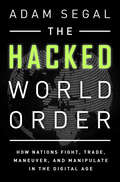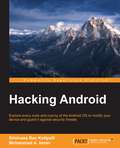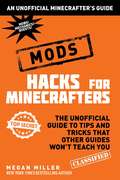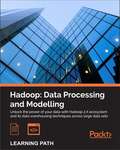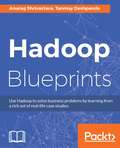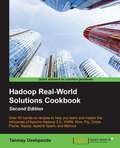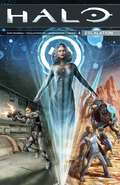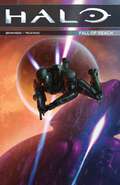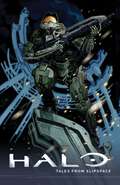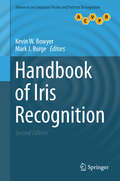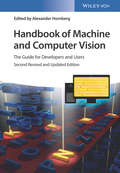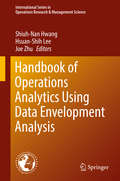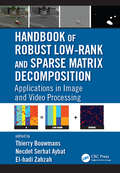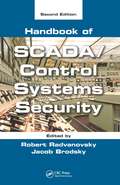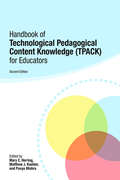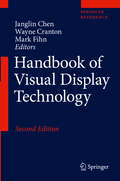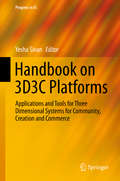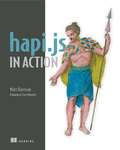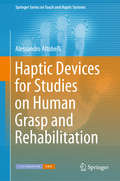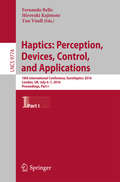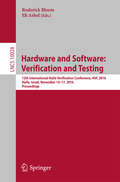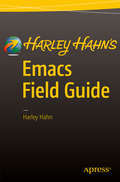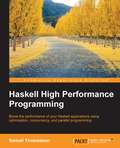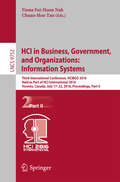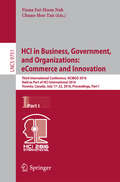- Table View
- List View
The Hacked World Order: How Nations Fight, Trade, Maneuver, And Manipulate In The Digital Age
by Adam SegalThe internet today connects roughly 2. 7 billion people around the world, and booming interest in the "internet of things" could result in 75 billion devices connected to the web by 2020. The myth of cyberspace as a digital utopia has long been put to rest. Governments are increasingly developing smarter ways of asserting their national authority in cyberspace in an effort to control the flow, organization and ownership of information. In A Hacked World Order, Adam Segal shows how governments use the web to wage war and spy on, coerce, and damage each other. Israel is intent on derailing the Iranian nuclear weapons program. India wants to prevent Pakistani terrorists from using their Blackberries to coordinate attacks. Brazil has plans to lay new fiber cables and develop satellite links so its Internet traffic no longer has to pass through Miami. China does not want to be dependent on the West for its technology needs. These new digital conflicts pose no physical threat--no one has ever died from a cyberattack--but they serve to both threaten and defend the integrity of complex systems like power grids, financial institutions, and security networks. Segal describes how cyberattacks can be launched by any country, individual, or private group with minimal resources in mere seconds, and why they have the potential to produce unintended and unimaginable problems for anyone with an internet connection and an email account. State-backed hacking initiatives can shut down, sabotage trade strategies, steal intellectual property, sow economic chaos, and paralyze whole countries. Diplomats, who used to work behind closed doors of foreign ministries, must now respond with greater speed, as almost instantaneously they can reach, educate, or offend millions with just 140 characters. Beginning with the Stuxnet virus launched by the US at an Iranian nuclear facility in 2010 and continuing through to the most recent Sony hacking scandal, A Hacked World Order exposes how the internet has ushered in a new era of geopolitical maneuvering and reveals the tremendous and terrifying implication on our economic livelihood, security, and personal identity.
Hacking Android
by Mohammed A. Imran Srinivasa Rao KotipalliExplore every nook and cranny of the Android OS to modify your device and guard it against security threats About This Book * Understand and counteract against offensive security threats to your applications * Maximize your device's power and potential to suit your needs and curiosity * See exactly how your smartphone's OS is put together (and where the seams are) Who This Book Is For This book is for anyone who wants to learn about Android security. Software developers, QA professionals, and beginner- to intermediate-level security professionals will find this book helpful. Basic knowledge of Android programming would be a plus. What You Will Learn * Acquaint yourself with the fundamental building blocks of Android Apps in the right way * Pentest Android apps and perform various attacks in the real world using real case studies * Take a look at how your personal data can be stolen by malicious attackers * Understand the offensive maneuvers that hackers use * Discover how to defend against threats * Get to know the basic concepts of Android rooting * See how developers make mistakes that allow attackers to steal data from phones * Grasp ways to secure your Android apps and devices * Find out how remote attacks are possible on Android devices In Detail With the mass explosion of Android mobile phones in the world, mobile devices have become an integral part of our everyday lives. Security of Android devices is a broad subject that should be part of our everyday lives to defend against ever-growing smartphone attacks. Everyone, starting with end users all the way up to developers and security professionals should care about android security. Hacking Android is a step-by-step guide that will get you started with Android security. You'll begin your journey at the absolute basics, and then will slowly gear up to the concepts of Android rooting, application security assessments, malware, infecting APK files, and fuzzing. On this journey you'll get to grips with various tools and techniques that can be used in your everyday pentests. You'll gain the skills necessary to perform Android application vulnerability assessment and penetration testing and will create an Android pentesting lab. Style and approach This comprehensive guide takes a step-by-step approach and is explained in a conversational and easy-to-follow style. Each topic is explained sequentially in the process of performing a successful penetration test. We also include detailed explanations as well as screenshots of the basic and advanced concepts.
Hacks for Minecrafters: The Unofficial Guide to Tips and Tricks That Other Guides Won't Teach You (Hacks For Minecrafters #1)
by Megan MillerMinecraft was originally designed to let other people modify it. Unlike the other successful gaming guides already on the market, this one is the first unofficial “hacker’s” guide specifically for adding mods (modifications) to your Minecraft game. Its hacks for Minecrafters are designed for players ages 7-12, but Minecrafters of every age will enjoy it and find it useful. This adventuring series is ideal for fans of the classic good vs. evil fight, magical schools like Hogwarts, and games like Pokemon GO, Minecraft, and Terraria. <p><p> With adding mods, Minecrafters can make their own adventures within Minecraft. Mods add content to the game that can change gameplay. This gives the players more options for how they play in the world of Minecraft. This Minecraft mods book can guide readers to adding new mechanics, mobs, and quests to their games as well as entirely new dimensions to play in. The rules of your gaming world can be changed with each and every mod you add! <p> This book is a great gift for any Minecraft lover in your life. It is one of several Megan Miller Minecraft books. Anyone interested in Minecraft mods will use this hacks for Minecrafters book.
Hadoop: Data Processing and Modelling
by Sandeep Karanth Garry Turkington Tanmay DeshpandeUnlock the power of your data with Hadoop 2.X ecosystem and its data warehousing techniques across large data sets About This Book * Conquer the mountain of data using Hadoop 2.X tools * The authors succeed in creating a context for Hadoop and its ecosystem * Hands-on examples and recipes giving the bigger picture and helping you to master Hadoop 2.X data processing platforms * Overcome the challenging data processing problems using this exhaustive course with Hadoop 2.X Who This Book Is For This course is for Java developers, who know scripting, wanting a career shift to Hadoop - Big Data segment of the IT industry. So if you are a novice in Hadoop or an expert, this book will make you reach the most advanced level in Hadoop 2.X. What You Will Learn * Best practices for setup and configuration of Hadoop clusters, tailoring the system to the problem at hand * Integration with relational databases, using Hive for SQL queries and Sqoop for data transfer * Installing and maintaining Hadoop 2.X cluster and its ecosystem * Advanced Data Analysis using the Hive, Pig, and Map Reduce programs * Machine learning principles with libraries such as Mahout and Batch and Stream data processing using Apache Spark * Understand the changes involved in the process in the move from Hadoop 1.0 to Hadoop 2.0 * Dive into YARN and Storm and use YARN to integrate Storm with Hadoop * Deploy Hadoop on Amazon Elastic MapReduce and Discover HDFS replacements and learn about HDFS Federation In Detail As Marc Andreessen has said "Data is eating the world," which can be witnessed today being the age of Big Data, businesses are producing data in huge volumes every day and this rise in tide of data need to be organized and analyzed in a more secured way. With proper and effective use of Hadoop, you can build new-improved models, and based on that you will be able to make the right decisions. The first module, Hadoop beginners Guide will walk you through on understanding Hadoop with very detailed instructions and how to go about using it. Commands are explained using sections called "What just happened" for more clarity and understanding. The second module, Hadoop Real World Solutions Cookbook, 2nd edition, is an essential tutorial to effectively implement a big data warehouse in your business, where you get detailed practices on the latest technologies such as YARN and Spark. Big data has become a key basis of competition and the new waves of productivity growth. Hence, once you get familiar with the basics and implement the end-to-end big data use cases, you will start exploring the third module, Mastering Hadoop. So, now the question is if you need to broaden your Hadoop skill set to the next level after you nail the basics and the advance concepts, then this course is indispensable. When you finish this course, you will be able to tackle the real-world scenarios and become a big data expert using the tools and the knowledge based on the various step-by-step tutorials and recipes. Style and approach This course has covered everything right from the basic concepts of Hadoop till you master the advance mechanisms to become a big data expert. The goal here is to help you learn the basic essentials using the step-by-step tutorials and from there moving toward the recipes with various real-world solutions for you. It covers all the important aspects of Hadoop from system designing and configuring Hadoop, machine learning principles with various libraries with chapters illustrated with code fragments and schematic diagrams. This is a compendious course to explore Hadoop from the basics to the most advanced techniques available in Hadoop 2.X.
Hadoop Blueprints
by Anurag Shrivastava Tanmay DeshpandeUse Hadoop to solve business problems by learning from a rich set of real-life case studies About This Book * Solve real-world business problems using Hadoop and other Big Data technologies * Build efficient data lakes in Hadoop, and develop systems for various business cases like improving marketing campaigns, fraud detection, and more * Power packed with six case studies to get you going with Hadoop for Business Intelligence Who This Book Is For If you are interested in building efficient business solutions using Hadoop, this is the book for you This book assumes that you have basic knowledge of Hadoop, Java, and any scripting language. What You Will Learn * Learn about the evolution of Hadoop as the big data platform * Understand the basics of Hadoop architecture * Build a 360 degree view of your customer using Sqoop and Hive * Build and run classification models on Hadoop using BigML * Use Spark and Hadoop to build a fraud detection system * Develop a churn detection system using Java and MapReduce * Build an IoT-based data collection and visualization system * Get to grips with building a Hadoop-based Data Lake for large enterprises * Learn about the coexistence of NoSQL and In-Memory databases in the Hadoop ecosystem In Detail If you have a basic understanding of Hadoop and want to put your knowledge to use to build fantastic Big Data solutions for business, then this book is for you. Build six real-life, end-to-end solutions using the tools in the Hadoop ecosystem, and take your knowledge of Hadoop to the next level. Start off by understanding various business problems which can be solved using Hadoop. You will also get acquainted with the common architectural patterns which are used to build Hadoop-based solutions. Build a 360-degree view of the customer by working with different types of data, and build an efficient fraud detection system for a financial institution. You will also develop a system in Hadoop to improve the effectiveness of marketing campaigns. Build a churn detection system for a telecom company, develop an Internet of Things (IoT) system to monitor the environment in a factory, and build a data lake - all making use of the concepts and techniques mentioned in this book. The book covers other technologies and frameworks like Apache Spark, Hive, Sqoop, and more, and how they can be used in conjunction with Hadoop. You will be able to try out the solutions explained in the book and use the knowledge gained to extend them further in your own problem space. Style and approach This is an example-driven book where each chapter covers a single business problem and describes its solution by explaining the structure of a dataset and tools required to process it. Every project is demonstrated with a step-by-step approach, and explained in a very easy-to-understand manner.
Hadoop Real-World Solutions Cookbook - Second Edition
by Tanmay DeshpandeOver 90 hands-on recipes to help you learn and master the intricacies of Apache Hadoop 2.X, YARN, Hive, Pig, Oozie, Flume, Sqoop, Apache Spark, and Mahout About This Book * Implement outstanding Machine Learning use cases on your own analytics models and processes. * Solutions to common problems when working with the Hadoop ecosystem. * Step-by-step implementation of end-to-end big data use cases. Who This Book Is For Readers who have a basic knowledge of big data systems and want to advance their knowledge with hands-on recipes. What You Will Learn * Installing and maintaining Hadoop 2.X cluster and its ecosystem. * Write advanced Map Reduce programs and understand design patterns. * Advanced Data Analysis using the Hive, Pig, and Map Reduce programs. * Import and export data from various sources using Sqoop and Flume. * Data storage in various file formats such as Text, Sequential, Parquet, ORC, and RC Files. * Machine learning principles with libraries such as Mahout * Batch and Stream data processing using Apache Spark In Detail Big data is the current requirement. Most organizations produce huge amount of data every day. With the arrival of Hadoop-like tools, it has become easier for everyone to solve big data problems with great efficiency and at minimal cost. Grasping Machine Learning techniques will help you greatly in building predictive models and using this data to make the right decisions for your organization. Hadoop Real World Solutions Cookbook gives readers insights into learning and mastering big data via recipes. The book not only clarifies most big data tools in the market but also provides best practices for using them. The book provides recipes that are based on the latest versions of Apache Hadoop 2.X, YARN, Hive, Pig, Sqoop, Flume, Apache Spark, Mahout and many more such ecosystem tools. This real-world-solution cookbook is packed with handy recipes you can apply to your own everyday issues. Each chapter provides in-depth recipes that can be referenced easily. This book provides detailed practices on the latest technologies such as YARN and Apache Spark. Readers will be able to consider themselves as big data experts on completion of this book. This guide is an invaluable tutorial if you are planning to implement a big data warehouse for your business. Style and approach An easy-to-follow guide that walks you through world of big data. Each tool in the Hadoop ecosystem is explained in detail and the recipes are placed in such a manner that readers can implement them sequentially. Plenty of reference links are provided for advanced reading.
Halo: Escalation Volume 4
by Duffy BoudreauAn unexpected ally joins a crack team of Spartans for their most dangerous operation—a secret mission into the mysterious Forerunner site known as the Absolute Record. The Halo® saga continues in this volume collecting Halo: Escalation #19–#24 by Duffy Boudreau (BlackAcre, Bloodshot), Ian Richardson (Noble Causes), and Douglas Franchin (Person of Interest).* An essential addition to the Halo canon!* The start of a new arc and a great jumping-on point for new readers!
Halo: Fall of Reach
by Brian ReedThe Master Chief&’s origin story!In the year 2517, humanity&’s last hope is with Dr. Catherine Halsey, the SPARTAN-II program, and one six-year-old boy: John-117. Kidnapped and ruthlessly trained, John endures and rises as the leader of the Spartans: he becomes the Master Chief! These legendary heroes are entrusted with stopping the Covenant at all costs…but will their harrowing biological augmentation and unparalleled MJOLNIR armor be enough to rise to victory?* From the lead writer of Halo 5: Guardians!* A perfect companion for the Halo: The Fall of Reach animated series!
Halo: Tales from Slipspace
by Variousn all-new original graphic novel anthology!This action-packed original graphic novel contains all-new Halo® stories from some of the comic industry&’s best—Jonathan Wayshak, Eric Nguyen, Alex Irvine, Vasilis Lolos, Kody Chamberlain, Dave Crosland, John Jackson Miller, Jonathan Goff, Simon Roy, and Halo: Escalation writer Duffy Boudreau—as well as 343 Industries&’ own franchise development director, Frank O&’Connor, and franchise producer, Tyler Jeffers!* This action-packed anthology is essential reading for all Halofans!* Standalone OGN is also great for new readers!
Handbook of Iris Recognition
by Kevin W. Bowyer Mark J. BurgeThe definitive work on iris recognition technology, this comprehensive handbook presents a broad overview of the state of the art in this exciting and rapidly evolving field. Revised and updated from the highly-successful original, this second edition has also been considerably expanded in scope and content, featuring four completely new chapters. Features: provides authoritative insights from an international selection of preeminent researchers from government, industry, and academia; reviews issues covering the full spectrum of the iris recognition process, from acquisition to encoding; presents surveys of topical areas, and discusses the frontiers of iris research, including cross-wavelength matching, iris template aging, and anti-spoofing; describes open source software for the iris recognition pipeline and datasets of iris images; includes new content on liveness detection, correcting off-angle iris images, subjects with eye conditions, and implementing software systems for iris recognition.
Handbook of Machine and Computer Vision: The Guide for Developers and Users
by Alexander HornbergThe second edition of this accepted reference work has been updated to reflect the rapid developments in the field and now covers both 2D and 3D imaging. Written by expert practitioners from leading companies operating in machine vision, this one-stop handbook guides readers through all aspects of image acquisition and image processing, including optics, electronics and software. The authors approach the subject in terms of industrial applications, elucidating such topics as illumination and camera calibration. Initial chapters concentrate on the latest hardware aspects, ranging from lenses and camera systems to camera-computer interfaces, with the software necessary discussed to an equal depth in later sections. These include digital image basics as well as image analysis and image processing. The book concludes with extended coverage of industrial applications in optics and electronics, backed by case studies and design strategies for the conception of complete machine vision systems. As a result, readers are not only able to understand the latest systems, but also to plan and evaluate this technology. With more than 500 images and tables to illustrate relevant principles and steps.
Handbook of Operations Analytics Using Data Envelopment Analysis
by Shiuh-Nan Hwang Hsuan-Shih Lee Joe ZhuThis handbook focuses on Data Envelopment Analysis (DEA) applications in operations analytics which are fundamental tools and techniques for improving operation functions and attaining long-term competitiveness. In fact, the handbook demonstrates that DEA can be viewed as Data Envelopment Analytics. Chapters include a review of cross-efficiency evaluation; a case study on measuring the environmental performance of OECS countries; how to select a set of performance metrics in DEA with an application to American banks; a relational network model to take the operations of individual periods into account in measuring efficiencies; how the efficient frontier methods DEA and stochastic frontier analysis (SFA) can be used synergistically; and how to integrate DEA and multidimensional scaling. In other chapters, authors construct a dynamic three-stage network DEA model; a bootstrapping based methodology to evaluate returns to scale and convexity assumptions in DEA; hybridizing DEA and cooperative games; using DEA to represent the production technology and directional distance functions to measure band performance; an input-specific Luenberger energy and environmental productivity indicator; and the issue of reference set by differentiating between the uniquely found reference set and the unary and maximal types of the reference set. Finally, additional chapters evaluate and compare the technological advancement observed in different hybrid electric vehicles (HEV) market segments over the past 15 years; radial measurement of efficiency for the production process possessing multi-components under different production technologies; issues around the use of accounting information in DEA; how to use DEA environmental assessment to establish corporate sustainability; a summary of research efforts on DEA environmental assessment applied to energy in the last 30 years; and an overview of DEA and how it can be utilized alone and with other techniques to investigate corporate environmental sustainability questions.
Handbook of Robust Low-Rank and Sparse Matrix Decomposition: Applications in Image and Video Processing
by Thierry Bouwmans, Necdet Serhat Aybat and El-hadi ZahzahHandbook of Robust Low-Rank and Sparse Matrix Decomposition: Applications in Image and Video Processing shows you how robust subspace learning and tracking by decomposition into low-rank and sparse matrices provide a suitable framework for computer vision applications. Incorporating both existing and new ideas, the book conveniently gives you one-stop access to a number of different decompositions, algorithms, implementations, and benchmarking techniques. Divided into five parts, the book begins with an overall introduction to robust principal component analysis (PCA) via decomposition into low-rank and sparse matrices. The second part addresses robust matrix factorization/completion problems while the third part focuses on robust online subspace estimation, learning, and tracking. Covering applications in image and video processing, the fourth part discusses image analysis, image denoising, motion saliency detection, video coding, key frame extraction, and hyperspectral video processing. The final part presents resources and applications in background/foreground separation for video surveillance. With contributions from leading teams around the world, this handbook provides a complete overview of the concepts, theories, algorithms, and applications related to robust low-rank and sparse matrix decompositions. It is designed for researchers, developers, and graduate students in computer vision, image and video processing, real-time architecture, machine learning, and data mining.
Handbook of SCADA/Control Systems Security
by Burt G. LookThis comprehensive handbook covers fundamental security concepts, methodologies, and relevant information pertaining to supervisory control and data acquisition (SCADA) and other industrial control systems used in utility and industrial facilities worldwide. Including six new chapters, six revised chapters, and numerous additional figures, photos, and illustrations, it addresses topics in social implications and impacts, governance and management, architecture and modeling, and commissioning and operations. It presents best practices as well as methods for securing a business environment at the strategic, tactical, and operational levels.
Handbook of Technological Pedagogical Content Knowledge (TPACK) for Educators
by Mary C. Herring, Matthew J. Koehler and Punya MishraThe 2nd edition of the Handbook of Technological Pedagogical Content Knowledge (TPACK) for Educators addresses the concept and implementation of technological pedagogical content knowledge—the knowledge and skills that teachers need in order to integrate technology meaningfully into instruction in specific content areas. Driven by the growing influence of TPACK on research and practice in both K-12 and higher education, the 2nd edition updates current thinking about theory, research, and practice. Offering a series of chapters by scholars in different content areas who apply the technological pedagogical content knowledge framework to their individual content areas, the volume is structured around three themes: Current thoughts on TPACK Theory Research on Technological Pedagogical Content Knowledge in Specific Subject Areas Integrating Technological Pedagogical Content Knowledge into Teacher Education and Professional Development The Handbook of Technological Pedagogical Content Knowledge (TPACK) for Educators is simultaneously a mandate and a manifesto on the engagement of technology in classrooms.
Handbook of Visual Display Technology
by Janglin Chen Wayne Cranton Mark FihnThe second Edition of this remarkable Handbook offers readers a comprehensive overview of the science and technology of visual displays and the economic and human interface factors associated with the displays industry. Unique in the displays field, the Handbook serves as a single reference source with expert contributions from over 150 international display professionals and academic researchers. The Handbook contains extensive coverage of established and emerging display technologies, with discussion of physical principles, materials science and processing, device technologies and particular areas of application. The wide-ranging content also encompasses the fundamental science of light and vision, image acquisition and manipulation, display materials and processing techniques, TFTs, display driving and metrology. Prominence is given to liquid crystal displays, with later chapters devoted to emerging technologies including flexible displays, electrophoretic, electrowetting and electrofluidic displays and MEMS-based displays. Other sections consider 3D display solutions, projection systems and head-worn displays. Updated and extended throughout, major changes in the 2nd Edition include: * Significantly expanded section on touch and human-computer interaction * Reworked and updated chapters on OLEDs * Revised and extended coverage of mobile display technologies ". . . no engineering or science library can be without this book. It will be an asset for all companies engaged in display and display-related business. " - extract from the Foreword of the 1st Edition by Dr M Anandan, President, Society for Information Display.
Handbook on 3D3C Platforms
by Yesha SivanThis book presents 3D3C platforms - three-dimensional systems for community, creation and commerce. It discusses tools including bots in social networks, team creativity, privacy, and virtual currencies & micropayments as well as their applications in areas like healthcare, energy, collaboration, and art. More than 20 authors from 10 countries share their experiences, research fi ndings and perspectives, off ering a comprehensive resource on the emerging fi eld of 3D3C worlds. The book is designed for both the novice and the expert as a way to unleash the emerging opportunities in 3D3C worlds. This Handbook maps with breadth and insight the exciting frontier of building virtual worlds with digital technologies. David Perkins, Research Professor, Harvard Graduate School of Education This book is from one of the most adventurous and energetic persons I have ever met. Yesha takes us into new undiscovered spaces and provides insight into phenomena of social interaction and immersive experiences that transform our lives. Cees de Bont, Dean of School of Design & Chair Professor of Design, School of Design of the Hong Kong Polytechnic University When you read 3D3C Platforms you realize what a domain like ours -- 3D printing -- can and should do for the world. Clearly we are just starting. Inspiring. David Reis, CEO, Stratasys Ltd This book provides a stunning overview regarding how virtual worlds are reshaping possibilities for identity and community. Th e range of topics addressed by the authors-- from privacy and taxation to fashion and health care--provide a powerful roadmap for addressing the emerging potential of these online environments. Tom Boellstorff , Professor, Department of Anthropology, University of California, Irvine Handbook on 3D3C Platforms amassed a unique collection of multidisciplinary academic thinking. A primer on innovations that will touch every aspect of the human community in the 21st century. Eli Talmor, Professor, London Business School
hapi.js in Action
by Matt HarrisonSummaryHapi.js in Action teaches you how to build modern Node-driven applications using hapi.js. Packed with examples, this book takes you from your first simple server through the skills you'll need to build a complete application. Foreword by Eran Hammer.Purchase of the print book includes a free eBook in PDF, Kindle, and ePub formats from Manning Publications.About the TechnologyThe hapi.js web framework for Node.js is built around three radical ideas. Developer productivity: hapi's intuitive setup gets you up and running in no time. Maintainability: hapi's modular design allows for easy scaling and improvement. Flexibility: hapi has a lightweight core that you can expand and customize with plugins. Are you ready to get hapi?About the BookHapi.js in Action is an incredibly practical book that teaches you to build APIs, servers, and applications using Node.js and the hapi.js framework. You'll begin with an easy-to-follow mental model of a Node.js web application and see exactly where hapi fits into the picture. Then, you'll walk through building an API and composing it into a web application. Along the way, you'll explore key topics like validation, testing, authentication, and deployment. Throughout, you'll learn how to build rock-solid, secure, and fast applications.What's InsideBest practices for Node application designBuilding APIs with hapiMaintaining and scaling applicationsExtending hapi with pluginsAbout the ReaderThis book assumes you have strong JavaScript skills. Experience with Node.js is helpful but not required.About the AuthorMatt Harrison is a core contributor to hapi.js and an active member of the Node community.Table of ContentsPART 1 - FIRST STEPSIntroducing hapiBuilding an APIBuilding a websitePART 2 - EXPANDING YOUR TOOLBOXRoutes and handlers in-depthUnderstanding requests and responsesValidation with JoiBuilding modular applications with pluginsCache me if you canPART 3 - CREATING ROCK-SOLID APPSAuthentication and securityTesting with Lab, Code, and server.inject()Production and beyond
Haptic Devices for Studies on Human Grasp and Rehabilitation
by Alessandro AltobelliThis book presents a new set of devices for accurate investigation of human finger stiffness and force distribution in grasping tasks. The ambitious goal of this research is twofold, the first is to advance the state of the art on human strategies in manipulation tasks and provide tools to assess rehabilitation procedure and the second is to investigate human strategies for impedance control that can be used for human robot interaction and control of myoelectric prosthesis. Part one describes two types of systems that are able to achieve a complete set of measurements on force distribution and contact point locations. The effectiveness of these devices in grasp analysis is also experimentally demonstrated and applications to neuroscientific studies are discussed. In part two, the devices are exploited in two different studies to investigate stiffness regulation principles in humans. The first study provides evidence on the existence of coordinated stiffening patterns in the fingers of human hands and establishes initial steps towards a real-time and effective modelling of finger stiffness in tripod grasp. The second study presents experimental findings on how humans modulate their hand stiffness whilst grasping objects of varying levels of compliance. The overall results give solid evidence on the validity and utility of the proposed devices to investigate human grasp properties. The underlying motor control principles that are exploited by humans in the achievement of a reliable and robust grasp can potentially be integrated into the control framework of robotic or prosthetic hands to achieve a similar interaction performance.
Haptics: Perception, Devices, Control, and Applications
by Fernando Bello Hiroyuki Kajimoto Yon VisellThe two-volume set LNCS 9774 and 9775 constitutes the refereed proceedings of the 10th International Conference EuroHaptics 2016, held in London, UK, in July 2016. The 100 papers (36 oral presentations and 64 poster presentations) presented were carefully reviewed and selected from 162 submissions. These proceedings reflect the multidisciplinary nature of EuroHaptics and cover topics such as perception of hardness and softness; haptic devices; haptics and motor control; tactile cues; control of haptic interfaces; thermal perception; robotics and sensing; applications.
Hardware and Software: Verification and Testing
by Roderick Bloem Eli ArbelThis book constitutes the refereed proceedings of the 12th International Haifa Verification Conference, HVC 2016, held in Haifa, Israel in November 2016. The 13 revised full papers and one tool paper presented were carefully reviewed and selected from 26 submissions. They are dedicated to advance the state of the art and state of the practice in verification and testing and are discussing future directions of testing and verification for hardware, software, and complex hybrid systems.
Harley Hahn's Emacs Field Guide
by Harley HahnEmacs, the world's most powerful text editor-based work environment, is easy to use, but far from easy to learn. As such, integrating Emacs into your personal world of thinking and creating is a long-term process. Harley Hahn, one of the most respected technical authors in the world, makes learning fun and stimulating. In this book, Hahn demystifies Emacs for programmers, students, and everyday users. The first part of the book carefully creates a context for your work with Emacs. What exactly is Emacs? How does it relate to your personal need to work quickly and to solve problems? Hahn then explains the technical details you need to understand to work with your operating system, the various interfaces, and your file system. In the second part of the book, Hahn provides an authoritative guide to the fundamentals of thinking and creating within the Emacs environment. You start by learning how to install and use Emacs with Linux, BSD-based Unix, Mac OS X, or Microsoft Windows. Written with Hahn's clear, comfortable, and engaging style, Harley Hahn's Emacs Field Guide will surprise you: an engaging book to enjoy now, a comprehensive reference to treasure for years to come. What you'll learn Special Emacs keys Emacs commands Buffers and windows Cursor, point, and region Kill/delete, move/copy, correcting, spell checking, and filling Searching, including regular expressions Emacs major modes and minor modes Customizing using your . emacs file Built-in tools, including Dired Games and Diversions Who this book is for Harley Hahn's Emacs Field Guide' is for programmers, students, and everyday users, who want an engaging and authoritative introduction to the complex and powerful Emacs working environment.
Haskell High Performance Programming
by Samuli ThomassonBoost the performance of your Haskell applications using optimization, concurrency, and parallel programming About This Book * Explore the benefits of lazy evaluation, compiler features, and tools and libraries designed for high performance * Write fast programs at extremely high levels of abstraction * Work through practical examples that will help you address the challenges of writing efficient code Who This Book Is For To get the most out of this book, you need to have a working knowledge of reading and writing basic Haskell. No knowledge of performance, optimization, or concurrency is required. What You Will Learn * Program idiomatic Haskell that's also surprisingly efficient * Improve performance of your code with data parallelism, inlining, and strictness annotations * Profile your programs to identify space leaks and missed opportunities for optimization * Find out how to choose the most efficient data and control structures * Optimize the Glasgow Haskell Compiler and runtime system for specific programs * See how to smoothly drop to lower abstractions wherever necessary * Execute programming for the GPU with Accelerate * Implement programming to easily scale to the cloud with Cloud Haskell In Detail Haskell, with its power to optimize the code and its high performance, is a natural candidate for high performance programming. It is especially well suited to stacking abstractions high with a relatively low performance cost. This book addresses the challenges of writing efficient code with lazy evaluation and techniques often used to optimize the performance of Haskell programs. We open with an in-depth look at the evaluation of Haskell expressions and discuss optimization and benchmarking. You will learn to use parallelism and we'll explore the concept of streaming. We'll demonstrate the benefits of running multithreaded and concurrent applications. Next we'll guide you through various profiling tools that will help you identify performance issues in your program. We'll end our journey by looking at GPGPU, Cloud and Functional Reactive Programming in Haskell. At the very end there is a catalogue of robust library recommendations with code samples. By the end of the book, you will be able to boost the performance of any app and prepare it to stand up to real-world punishment. Style and approach This easy-to-follow guide teaches new practices and techniques to optimize your code, and then moves towards more advanced ways to effectively write efficient Haskell code. Small and simple practical examples will help you test the concepts yourself, and you will be able to easily adapt them for any application.
HCI in Business, Government, and Organizations: Information Systems
by Fiona Fui-Hoon Nah Chuan-Hoo TanThis volume constitutes the refereed proceedings of the Third International Conference on HCI in Business, Government and Organizations, HCIBGO 2016, held as part of the 18th International Conference on Human-Computer Interaction, HCII 2016, which took place in Toronto, Canada, in July 2016. HCII 2016 received a total of 4354 submissions, of which 1287 papers were accepted for publication after a careful reviewing process. The 43 papers presented in this volume were organized in topical sections named: designing information systems; HCI in the public administration and government; HCI at work; and mobile applications and services.
HCI in Business, Government, and Organizations: eCommerce and Innovation
by Chuan-Hoo Tan Fiona Fui-Hoon NahThis volume constitutes the refereed proceedings of the Third International Conference on HCI in Business, Government and Organizations, HCIBGO 2016, held as part of the 18th International Conference on Human-Computer Interaction, HCII 2016, which took place in Toronto, Canada, in July 2016. HCII 2016 received a total of 4354 submissions, of which 1287 papers were accepted for publication after a careful reviewing process. The 53 papers presented in this volume are organized in topical sections named: social media for business; electronic, mobile and ubiquitous commerce; business analytics and visualization; branding, marketing and consumer behavior; and digital innovation.
